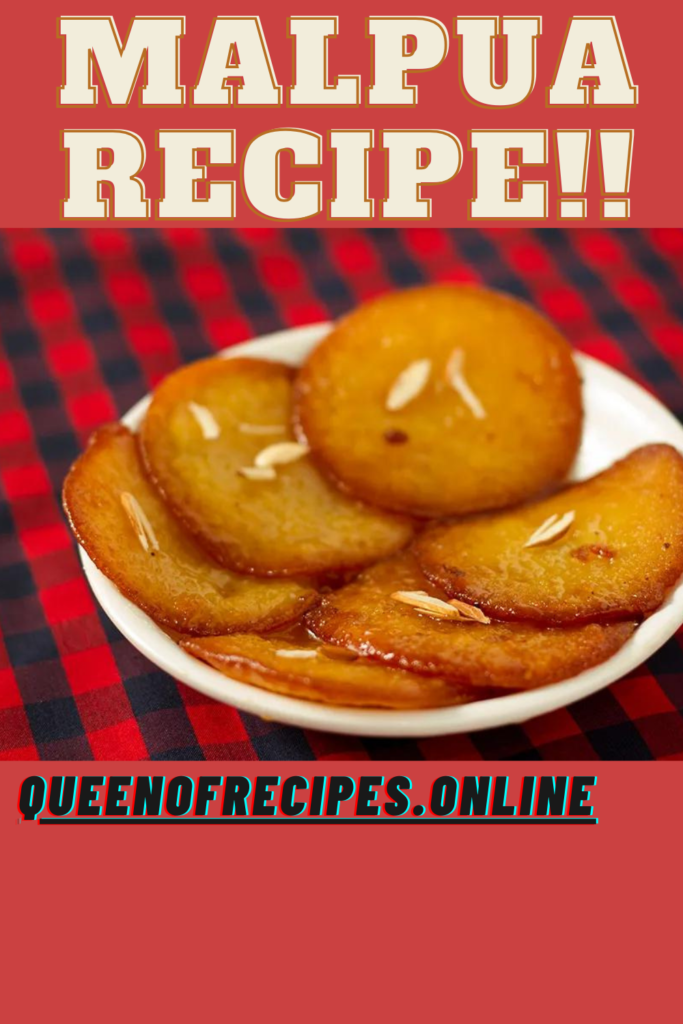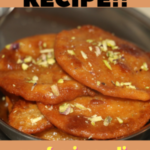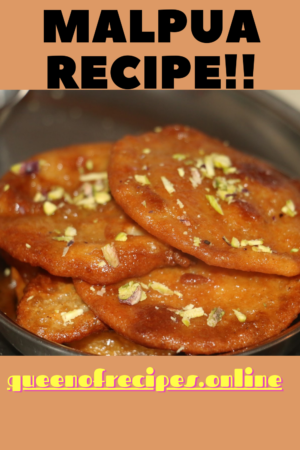Table of Contents
About Malpua.
Malpua is a delectable Indian dessert that holds a cherished place in the country’s culinary traditions. These sweet, fluffy pancakes are typically made during festive occasions and celebrations. Malpua batter is prepared with ingredients like flour, milk, and sugar, and it’s often flavored with cardamom or fennel seeds. The batter is deep-fried to golden perfection and then soaked in a fragrant sugar syrup, imparting a delightful sweetness. It can be served as a standalone treat or accompanied by toppings like rabri (sweet, thickened milk), nuts, or grated coconut, making it a truly indulgent dessert enjoyed by people across India.
To make delicious Malpua at home, follow this traditional Indian recipe:
Ingredients:
For Malpua Batter:
- 1 cup all-purpose flour (maida)
- 1/4 cup semolina (sooji)
- 1/2 cup milk
- 1/4 cup yogurt (curd)
- 1/4 teaspoon cardamom powder
- 1/4 teaspoon fennel seeds (saunf)
- A pinch of baking soda
- Ghee or oil for frying
For Sugar Syrup:
- 1 cup sugar
- 1/2 cup water
- A few saffron strands (optional)
- 1/4 teaspoon cardamom powder
Instructions:
1. Prepare the Sugar Syrup:
- In a saucepan, combine sugar and water and bring it to a boil.
- Add saffron strands and cardamom powder for flavor (optional).
- Simmer until the syrup reaches a one-string consistency. To test, take a drop of syrup between your thumb and forefinger; it should form a single thread when pulled apart. Remove from heat and keep it warm.
2. Prepare the Malpua Batter:
- In a mixing bowl, combine all-purpose flour, semolina, cardamom powder, and fennel seeds.
- Add milk and yogurt, and mix well to form a smooth batter without lumps.
- Let the batter rest for about 30 minutes. This helps the semolina absorb the liquid.
3. Fry the Malpua:
- Heat ghee or oil in a shallow frying pan or skillet over medium heat.
- Once the oil is hot, add a small ladleful of batter into the pan. You can make small or large Malpuas, depending on your preference.
- Fry until the bottom side turns golden brown, then flip and cook the other side until golden.
- Use a slotted spoon to remove it from the pan, allowing excess oil to drain.
4. Soak in Sugar Syrup:
- Immediately place the fried it into the warm sugar syrup.
- Let it soak for a minute or two, ensuring that it absorbs the syrup.
5. Serve:
- Garnish with chopped nuts, grated coconut, or a drizzle of rabri (sweet thickened milk), if desired.
- Serve it warm and enjoy this delightful Indian dessert!
It is a delightful treat often prepared during festivals like Holi and Diwali or enjoyed as a sweet indulgence with a cup of chai.


Nutritional Value.
The nutritional value of it can vary depending on its size, ingredients, and the cooking method used. Here’s an approximate nutritional profile for one average sized Malpua (about 50 grams):
- Calories: 150-180 calories
- Carbohydrates: 25-30 grams
- Protein: 2-3 grams
- Fat: 6-8 grams
- Sugar: 10-15 grams
- Fiber: 1-2 grams
- Cholesterol: 10-15 mg
- Sodium: 5-10 mg
Please note that these values are estimates and can vary based on factors such as the type and quantity of oil or ghee used for frying and the amount of sugar syrup absorbed by the Malpua. Malpua is a sweet and deep-fried dessert, so it tends to be calorie-dense and relatively high in sugar and fat. Enjoy it in moderation as an occasional treat.
Health Benefits.
Malpua, a traditional Indian dessert, is primarily known for its delightful taste and texture rather than its health benefits. However, it does offer some nutritional value and can be enjoyed in moderation as part of a balanced diet. Here are a few potential health benefits of it:
- Rich in Energy: It is calorie-dense, making it a quick source of energy. This can be beneficial for individuals who need an energy boost, especially during festivals or special occasions.
- Source of Carbohydrates: It contains carbohydrates from ingredients like all-purpose flour and semolina. Carbohydrates are essential for providing energy to the body.
- Moderate Protein: While not a significant source of protein, it does contain a small amount of protein from ingredients like milk and yogurt.
- Cultural Significance: It is often prepared and shared during cultural and religious festivals, promoting a sense of community and tradition.
- Occasional Indulgence: Enjoying it on special occasions can contribute to overall well-being by allowing individuals to savor the pleasures of traditional and festive foods in moderation.
It’s important to note that it is a sweet and deep-fried dessert, so it is high in sugar and fat. As such, it should be consumed in moderation as an occasional treat rather than a regular part of the diet. Balancing indulgent foods like Malpua with a well-rounded and nutritious diet is key to maintaining overall health.
Tips and Tricks.
Making perfect it requires some skill and finesse. Here are some tips and tricks to help you master the art of preparing this delightful Indian dessert:
- Batter Consistency: Achieving the right batter consistency is crucial. The batter should be thick yet pourable. If it’s too thick, add a little milk to thin it out; if it’s too thin, add a bit more flour.
- Resting Time: Allow the Malpua batter to rest for at least 30 minutes or longer. This resting period helps the semolina (sooji) absorb the liquid, resulting in a better texture.
- Frying Temperature: Heat the ghee or oil to the right temperature before frying it. The oil should be moderately hot, not too hot, to ensure even cooking and a golden-brown color.
- Frying Technique: Use a shallow pan or skillet for frying and pour the batter gently to form small or medium-sized it. Fry on medium-low heat to prevent burning and ensure that the Malpuas cook through.
- Flipping Carefully: When flipping it, do it gently to avoid splattering hot oil. Use a flat spatula to ensure even cooking on both sides.
- Sugar Syrup: Prepare the sugar syrup while it is frying, so it’s warm when you soak them. Ensure the sugar syrup is of one-string consistency for the best results.
- Soaking Time: Dip each fried it in the sugar syrup for just a minute or two. Over-soaking can make them soggy, while a shorter soak may not allow the syrup to penetrate properly.
- Garnishes: Be creative with garnishes. Top it with chopped nuts like pistachios or almonds, grated coconut, or a drizzle of rabri (sweet, thickened milk) for added flavor and texture.
- Serving Temperature: Serve it warm. They are at their best when freshly made and soaked in warm sugar syrup.
- Storage: If you have leftovers, store them in an airtight container at room temperature for a day or two. Reheat them before serving to regain their crispness.
With these tips in mind, you’ll be well-prepared to make delicious Malpua that is crispy on the outside and soft on the inside, with just the right amount of sweetness.


Serving Suggestions.
It is a delightful Indian dessert that can be enjoyed in various ways. Here are some serving suggestions to enhance your Malpua experience:
- As Is: It can be enjoyed on its own, fresh out of the frying pan. The crispy edges and sweet, syrup-soaked center make it a delicious standalone treat.
- With Rabri: A classic pairing for it is rabri, which is sweet, thickened milk. Drizzle a generous amount of rabri over it for a rich and creamy contrast.
- Chopped Nuts: Garnish it with finely chopped nuts like almonds, pistachios, or cashews. These add a delightful crunch and nutty flavor to each bite.
- Grated Coconut: Sprinkle freshly grated coconut over it for a tropical twist and a bit of extra texture.
- Fruit Compote: Serve it with a fruit compote or fruit salad on the side. The fruity sweetness complements the dessert’s richness.
- Vanilla Ice Cream: If you’re feeling indulgent, a scoop of vanilla ice cream alongside warm it creates a delightful hot-and-cold contrast.
- Cardamom Powder: A light dusting of ground cardamom on top of it can enhance its flavor and aroma.
- Rosewater Syrup: For a floral touch, drizzle a few drops of rosewater syrup over it.
- Cinnamon Sugar: Dust it with a mixture of cinnamon and sugar for a warm and comforting flavor.
- Mango Puree: During mango season, pair it with a fresh mango puree for a tropical twist.
Remember that it is a sweet and indulgent dessert, so feel free to experiment with different toppings and accompaniments to suit your taste preferences. Whether you enjoy it traditionally or with a modern twist, it is a treat that’s sure to satisfy your sweet tooth.
FAQs.
What does Malpua taste like?




Malpua is a delightful Indian dessert known for its sweet and indulgent flavor. When you bite into a Malpua, you’ll experience a combination of tastes. The outer edges are slightly crispy, providing a subtle crunch, while the center is soft and syrup-soaked, delivering a burst of sweetness. Depending on the recipe, Malpua may also have hints of aromatic spices like cardamom or fennel seeds, adding layers of flavor to the overall taste. It’s a dessert that balances texture and sweetness beautifully, making it a beloved treat during festive occasions.
Is Malpua suitable for vegans?


Malpua, in its traditional form, is not suitable for vegans because it contains dairy products such as milk and yogurt. However, it is possible to make a vegan version of Malpua by using plant-based alternatives such as almond milk or coconut yogurt instead of dairy milk and yogurt. Additionally, you would need to substitute ghee with a vegan-friendly cooking oil or vegan butter. With these substitutions, you can enjoy a vegan friendly Malpua that retains the sweet and indulgent flavors of the original dessert.
How do I store leftover Malpua?




Storing leftover Malpua is quite simple. Here’s how to do it:
Cool Completely: Allow the leftover Malpua to cool to room temperature on a wire rack or paper towels. This prevents condensation and helps maintain their texture.
Use an Airtight Container: Place the Malpua in an airtight container. If you need to stack them, separate each layer with parchment paper or wax paper to prevent sticking.
Store at Room Temperature: You can keep leftover Malpua at room temperature for a day or two. Make sure the container is sealed tightly to prevent them from becoming stale.
Reheat Before Serving: When you’re ready to enjoy the leftover Malpua, reheat them in a microwave or oven to regain their crispness and warmth. Alternatively, you can lightly pan-fry them for a few seconds on each side.
Avoid Refrigeration: It’s best not to refrigerate Malpua as they can become soggy when exposed to moisture. Room temperature storage is ideal for retaining their texture.
By following these steps, you can enjoy the leftover Malpua without compromising their taste and texture.
Can I make Malpua without deep-frying?




Yes, you can make a healthier version of Malpua without deep-frying. Here’s how:
Shallow Frying: Instead of deep-frying, use a non-stick frying pan or skillet. Heat a small amount of oil or ghee and pour the Malpua batter into the pan to form smaller pancakes.
Minimal Oil: Use as little oil or ghee as possible to coat the pan’s surface. You can also use a non-stick cooking spray to further reduce the amount of fat used.
Cook on Low Heat: Fry the Malpua on low to medium-low heat to ensure even cooking without burning. Flip them carefully to maintain their shape.
While shallow-fried Malpua won’t be as crispy as the deep-fried version, it can still be delicious and significantly reduce the calorie content, making it a healthier alternative.

